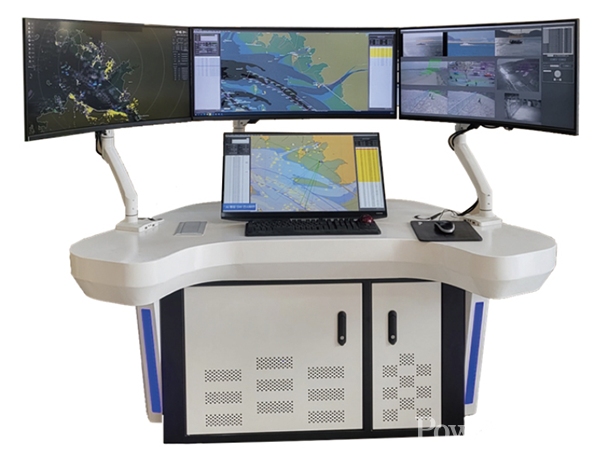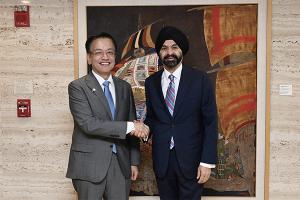 |
||
Defense industry specialist for coastal vigilance and surveillance prepares for future warfare through convergence of Industry 4.0 technologies
The company is a leading defense tactical data link and a defense industry company dealing with KVMF, BMS, wired and wireless communications, defense M&S, and information and communication infrastructure, and is developing advanced products and technologies to prepare for future warfare through the convergence of the 4th industrial revolution technologies such as big data, artificial intelligence, and the Internet of Things. It has a wide range of technology capabilities for national security and defense, including modeling and simulation for KVMF, BMS, naval warfare models, ASTT, AI convergence coastal border system, intelligent situational awareness platform based on AI, AR and AVM, and TOD AI object recognition warning system. By applying innovative ICT new technologies to national defense, the company has developed a variety of equipment and solutions, including a ground perimeter operation support system, safety and distress identification devices for ship crews, navigational safety using AR and AVM technologies, and a ship’s battlefield visualization system for distant target identification. In 2019, the company successfully developed the Navy’s low-power wide-area communication distress radio identification device as a defense experiment project, which is the first low-power distance communication-based distress radio identification device developed in Korea. In 2020, it successfully completed a defense experiment project to build a ship’s AVM full-length visibility system, enabling safe navigation and comprehensive situational awareness during maritime operations through technologies such as ship collision prediction and analysis and autonomous operation of unmanned ships. It also participated as the lead company in the AI Convergence Coastal Border System, a new defense ICT project, from 2021 to 2023 and completed the demonstration at the Army Coast Guard Unit. “We are a defense company dealing with tactical data links, battlefield management, wired and wireless communications, network integration, defense M&S, ship collision prevention and analysis systems, and information and communication infrastructure systems. We are committed to enhancing our competitiveness through the convergence of 4th industrial revolution technologies such as big data, AI, and IoT” says CEO Kwon Hong-joon.
 |
‘AI Convergence Coastal Border System’ to share coastal conditions in real time and integrate coastal border equipment
The AI Convergence Coastal Border System is an intelligent solution that can detect and identify coastal objects such as ships and people by fusing artificial intelligence technology with military coastal border data, data processing and analysis, and artificial intelligence learning in conjunction with the Army’s Scientized Border System project. It is also an integrated system for the integrated operation of coastal warning equipment and a system for sharing coastal conditions in real time. In recent years, as the military’s operational concept has shifted to a force-saving coastline, there has been a need to address the increased workload of coastal surveillance personnel, the different operating systems of coastal surveillance equipment, and the risk of gaps in the coastline due to reliance on visual surveillance. The company’s AI convergence coastal border system, developed in response to this need, is expected to play a leading role in building a successful scientificized border system by utilizing big data analysis and artificial intelligence, the core technologies of the Fourth Industrial Revolution. It is equipped with an optical image-based object recognition AI model that can identify objects such as people, ships, aircraft, and vehicles, and can quickly recognize abnormal situations such as infiltration and loitering, which not only minimizes human error for surveillance operators, but also dramatically improves coastal surveillance operations. The system can maximize joint and cooperative operation capabilities by establishing a real-time situation sharing system with nearby related agencies such as the Navy, Air Force, Marines, and police and maritime police, centered on the Army Coast Guard. “This is an AI-based intelligent coastal border integration system that links various surveillance and control systems such as video and signaling equipment. It enables relevant agencies to work together to quickly take initial measures in the event of an emergency, which can help respond to defense resource constraints such as military shortages and future security threats, including the North Korean threat” says Kwon. The company has completed the demonstration phase of the AI convergence coast guard system and is in trial operation at the Army Coast Guard Unit, and plans to further expand the scope of operation in the future. The company is developing a maritime object AI identification system that can be used for real-time ship identification during maritime operations at ships, bases, and land command centers, and will utilize artificial intelligence technology and high-compression video transmission technology.
 |
‘Intelligent situational awareness platform based on AI, AR, and AVM’ eliminates blind spots to support comprehensive situational awareness in operations
In addition to the AI convergence coastal warning system, GDL System has also developed an intelligent situational awareness platform based on AI, AR, and AVM. Currently, naval ships are performing operational missions with limited equipment and manpower, and it is essential to monitor the battlefield situation around the clock. However, the existing video surveillance equipment and security personnel provide limited video and visual information, resulting in blind spots. In particular, even if various sensor equipment such as video surveillance equipment, navigation equipment, RADAR, and AIS are in operation, there is no system that integrates and visualizes the information provided by each equipment, which limits quick decision-making. The company developed this platform based on the experience of successfully conducting an AVM pilot project to build a battlefield visualization system as a defense experiment project in 2020. The system applies AVM technology and augmented reality to the images collected from the ship’s video surveillance equipment to comprehensively display the situation around the ship, and can display 360-degree distant target identification and air threat tracks using EO/IR and wide-angle lens cameras. The system will apply AI, AR, and AVM technologies to raw data (video) acquired in real time and navigation data such as GPS and AIS, and provide synthesized results to ship operators. “The AVM pilot project for establishing a battlefield visualization system applies AVM technology to illuminate the ship in all directions to eliminate blind spots for external threats and strengthen the vigilance surveillance function, while displaying information provided by navigation equipment, RADAR, etc. using augmented reality technology on the all-round video information using the same technology. This provides situational judgment functions such as rapid and accurate target identification and collision risk analysis, and helps to build a system that enables comprehensive situational judgment when performing safe navigation and operational missions” says Kwon.
 |
TOD AI Object Recognition Warning System’ detects anomalies in real-time and provides fast, complete object recognition
Recognized by the Minister of Defense for contributing to new defense ICT technology projects
The TOD AI object recognition warning system is also worth mentioning. It is a warning system that detects abnormal situations and recognizes objects in real time by applying artificial intelligence technology to TOD (thermal imaging device) images. It can recognize abnormal situations and objects in TOD images in real time, and recognizes all abnormal situations such as the appearance and movement of people, animals, and vehicles. The system receives the output video of TOD in real time and can operate by selecting a network model that prioritizes performance or speed, and can set alerts for key objects of interest. It can also save screenshots of key events and recognize objects in the saved footage, so that it can respond quickly and reliably when various events occur. Another big advantage is that the installation cost is low because the AI technology can be applied to existing thermal imaging equipment. This means that the software can be added to the existing equipment without replacing the hardware, and it can be used in the field immediately, so the latest system can be built at a minimal cost. In recognition of its development of these various defense solutions, GDL System was selected as a contractor for the Daejeon Defense Venture Center in 2014 and received the Commander of the Naval Submarine Force Commendation in 2016. The company also received the Innovation Award (Excellence Award) at the World IT Show 2021 exhibition, and in 2022, it was selected as one of the 1000 National Companies in the Defense Industry by the Korea Defense Acquisition Program Administration. In February 2023, the company received the Minister of Defense Commendation for its contributions to defense ICT new technology projects at the ‘ICT New Technology Defense Activity Proposal Presentation’. “We will develop and upgrade our unique innovative technologies with a creative and challenging spirit, and devote ourselves to research and development for national security and defense” says Kwon.
신태섭 기자 tss79@naver.com







